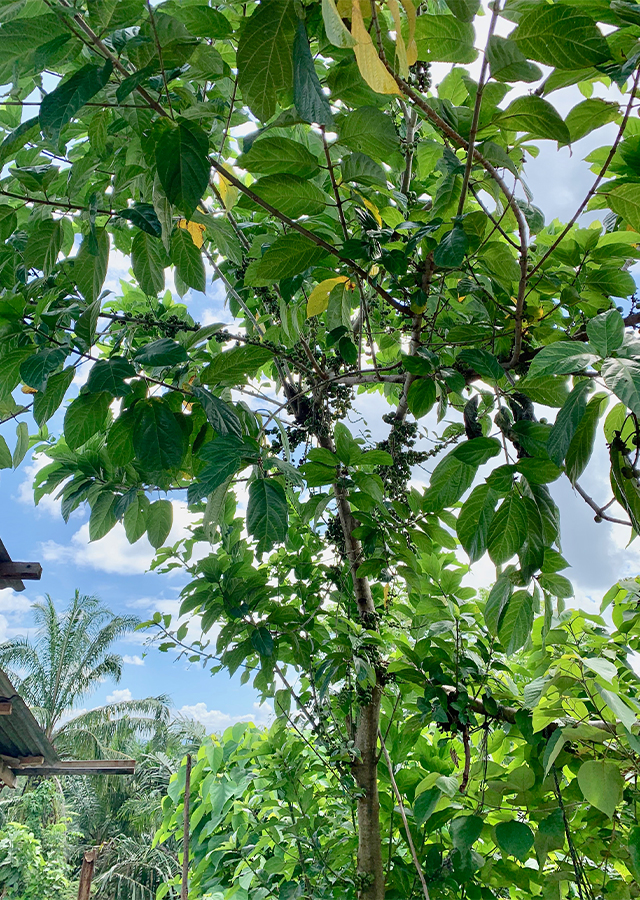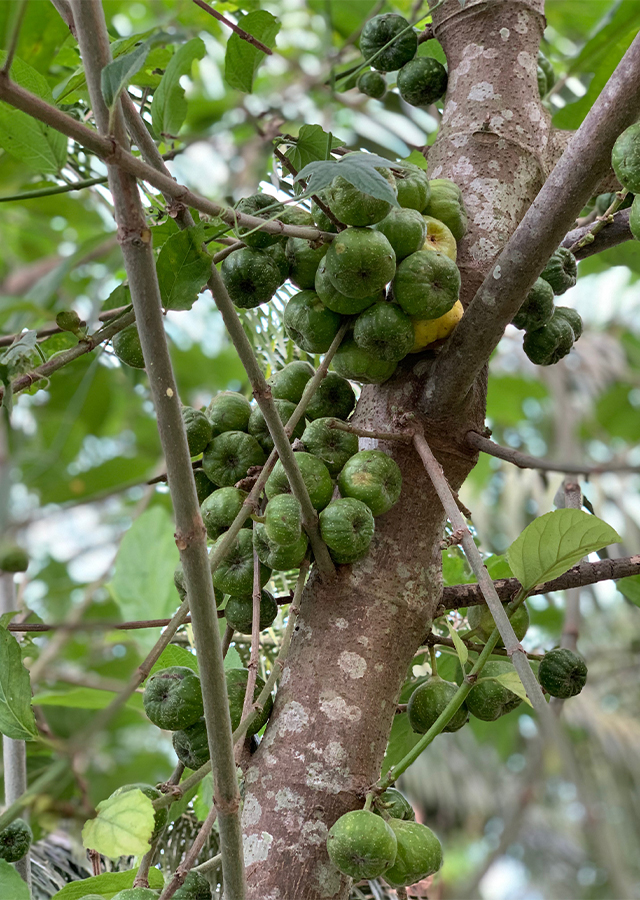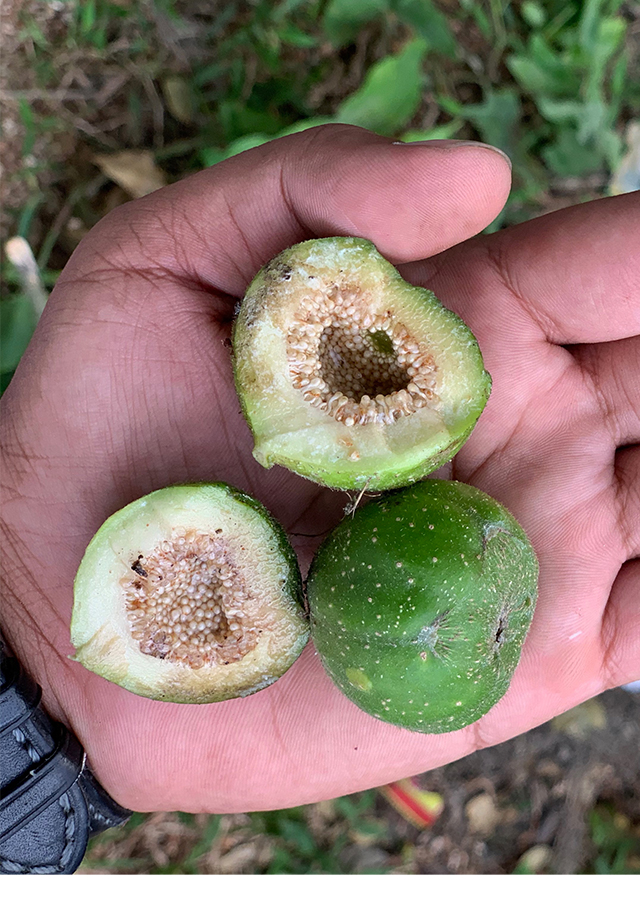Hairy Fig
Ficus hispida L.f.
Moraceae
Location in our garden
Principal



Synonym
Covellia assamica Miq.
Covellia courtallensis Miq.
Covellia daemonum (J.Koenig ex Vahl) Miq.
Habitus
Trees. A shrub or small perennial evergreen tree with a spreading crown, can grow up to 17 m tall
Part Used
Leaves
Bark
Fruit
Latex
Roots
Growing Requirements
Full Sunshine
Habitat
Wetland
Riverbanks
Forest
Overview
Due to its numerous pharmacological activities, the Hairy fig is a valuable herb. Almost all parts of this plant are used by Indian traditional healers as a folklore remedy for the treatment of different ailments, but the leaves are of special interest from a medicinal point of view. The fruits are emetic and cause intestinal inflammation in amounts, which can lead to death.
Vernacular Names
Dui ye rong (Chinese), Gobla (Hindi-India), Ara bumbong (Malaysia), Ma duea plong (Thai), Luwing/Bisoro (Indonesia), Dua pong (Laos), Ngai (Vietnam).
Agroecology
Hairy fig tree can be found throughout the year, commonly grows in secondary lowland forest with per-humid to monsoon climates. Especially, grows in open places along the base of foothills at altitudes of 500-1,100 m, along rivers and forest edges, and is sometimes cultivated in villages in India, Sri Lanka, Myanmar, the Southern area of the Republic of China, Thailand, Peninsular Malaysia, Sumatra, Borneo, Java, Sulawesi, The Lesser Sunda Islands, New Guinea, Australia and Andaman Island for shade and its edible fruits.
Morphology
- Bark - smooth, grey, exudate pale brown or turning pink and then pale brown on exposure.
- Leaves - simple, often decussate, ovate, oblong, or obovate-oblong, thickly papery, covered with coarse hairs, stipules 1-2.5 cm long.
- Flowers -three kinds of flower are produced by the trees; a male, a long-styled female and a short-styled female flower, also called the gall flower, are all found within the structure that we generally think of as the fruit. Male flowers: multiple and near apical pore; three lobed, thinly membranous calyx; stamen 1. all flowers (female short-form): absent calyx; subapical, short, and thick style. Female flowers: absence of calyx lobes; lateral style of hair.
- Fruits - figs appear on regular leafy shoots in the leaf axil, often on branchlets without leaves, solitary or paired, yellow or red when ripe, top-shaped, obovoid, densenly brown pubescent and 1.2-3 cm in diameter.
- Seeds - cotyledons orbicular, about 2-3 mm diameter.
Cultivation
- Propagated through seeds, germinates best at a temperature around 20 °C.
- Air layering.
- Tip cuttings around 4-12cm long, taken from lateral branches.
- Root suckers.
Chemical Constituents
Alkaloids, terpenoids, tannins, phenol, saponins, anthraquinone, glycoside, sterols, amino acid and flavonoids.
Traditional Medicinal Uses
Medicinal Uses
- Leaf extract: capable of repairing liver damage caused by paracetamol and azothioprine.
- Leaves and twigs extract: an alkaloid of pehnanthroindolizidine isolated from the leaves and twigs, found to be involved in small human cancer cell panels.
- A protease of suphydryl plant in the latex of F. hispida was found to have the ability to increase the clotting time and sedimentation rate of erythrocytes while reducing the content of hemoglobin. It also has a moderate anti-inflammatory role.
Traditional Uses
- Gastrointestinal diseases: latex is used for the prevention of childhood diarrhea, dysentery and stomachache. The fig is widely recommended by Ayurvedic physicians for use in the treatment of jaundice through the latex of the leaves.
- Obstetrics and gynaecological diseases: for use in vaginal discharge and in the cessation of breast milk (plant); as a galactagogue (fruit); for the promotion of childbirth (the leaves).
- Other diseases: for the treatment of flu, common cold, conjunctivitis, bronchitis, and post-injury painful swelling, and for the treatment of haemorrhoids, epistaxis, and gastrointestinal bleeding. The fruit and root were used for the treatment of skin problems such as leucoderma and vitiligo.
- Boiled leaves are used to ulceration of the nose and poultice boils.
- An extract of the bark is used in the treatment of anaemia, jaundice, and leprosy.
Part Used
Reference Sources
- Australian Tropical Rainforest Plants. (No date). Ficus hispida. http://www.canbr.gov.au/cpbr/cd-keys/RFK7/key/RFK7/Media/Html/entities/Ficus_hispida.htm 29-08-2020
- Globinmed. (No date). Ficus hispida. https://www.globinmed.com/index.php?option=com_content&view=article&id=104415:ficus-hispida&catid=199&Itemid=139 29-08-2020
- Mohammad Ali and Nisha Chaudhary. (2011). Ficus hispida Linn.: A review of its pharmacognostic and ethnomedicinal properties. Journal List Pharmacognosy Review.v5(9). pp.96–102. doi: 10.4103/0973-7847.79104. http://www.phcogrev.com/article/2011/5/9/1041030973-784779104 29-08-2020
- Fern, ken. (2019). Useful Tropical Plants Database. Ficus hispida l.f. http://tropical.theferns.info/viewtropical.php?id=Ficus+hispida 29-08-2020
- Rojo, J.P., Pitargue, F.C., & Sosef, M.S.M. (2016). Plant Resources of South-East Asia: Medicinal Plant. https://uses.plantnet-project.org. Accessed on 25 October 2021.


